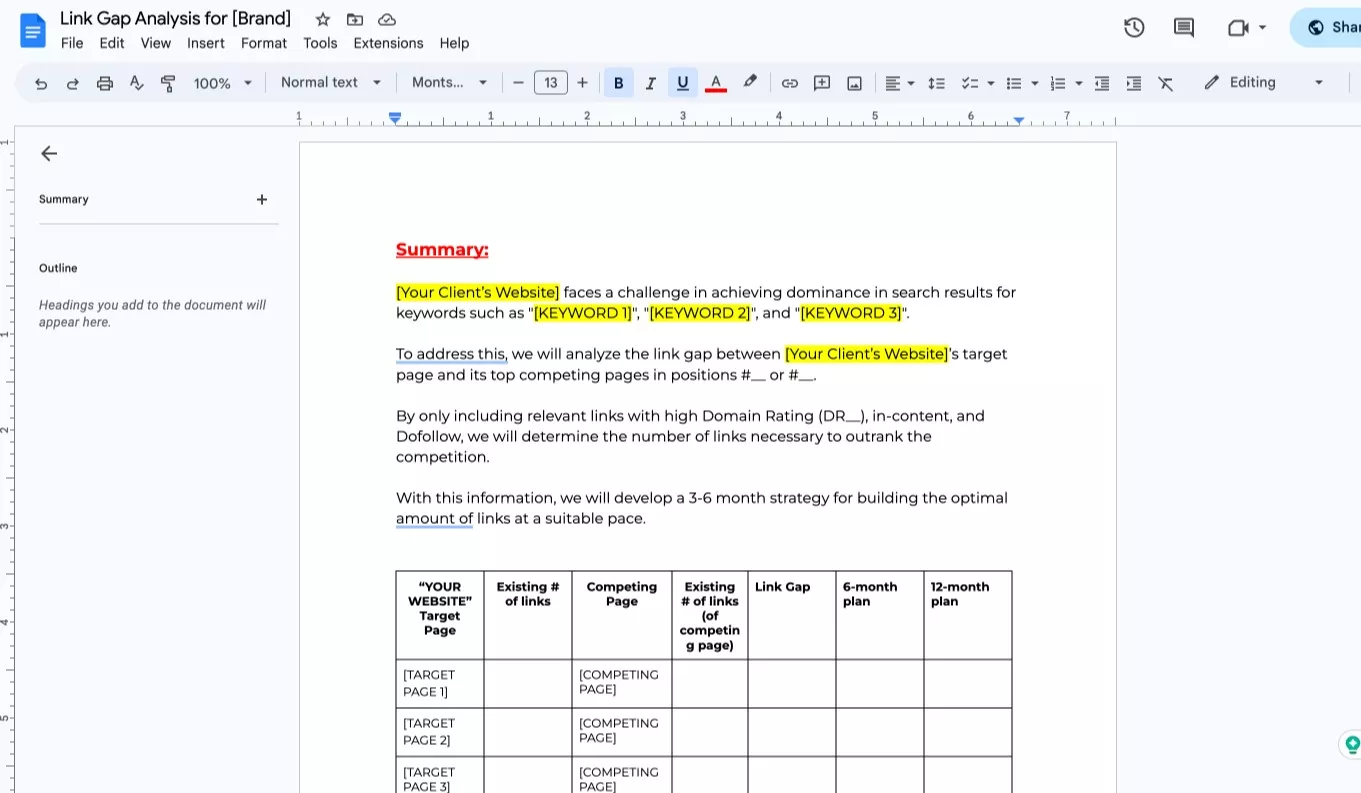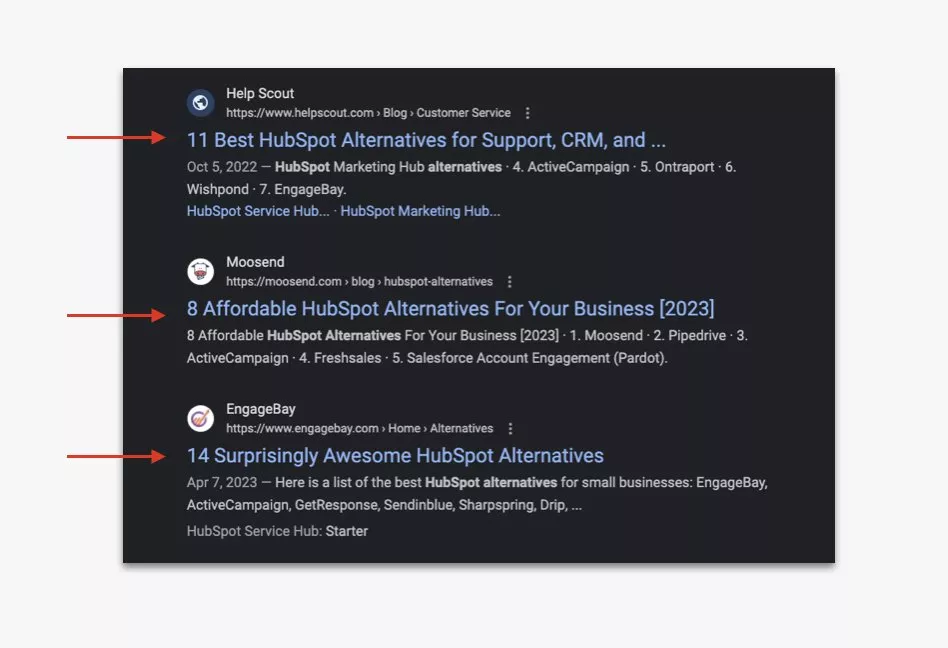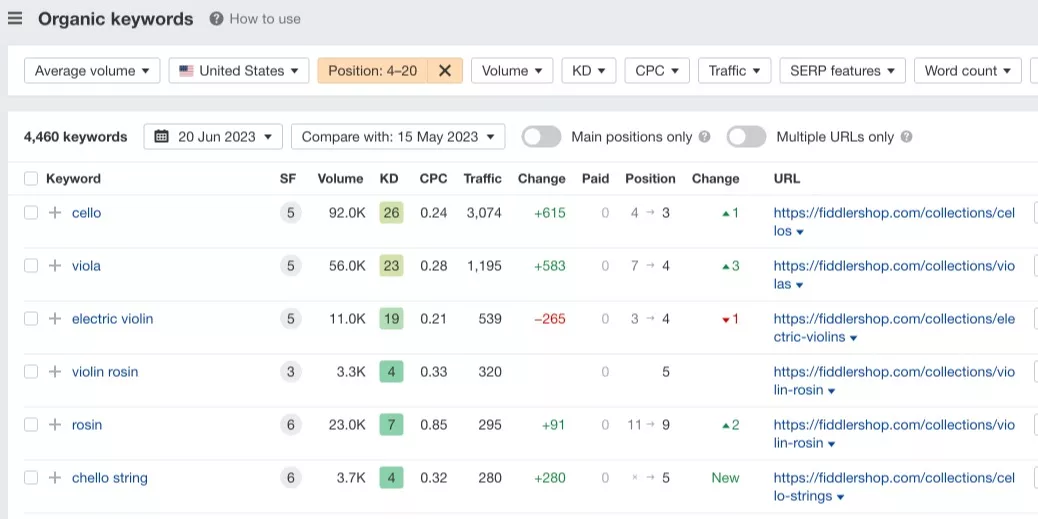by Venchito Tampon Jr | Last Updated on June 26, 2023
How many backlinks do I need to rank?
The number of backlinks you need to rank for your website can vary from 0 to 300+ backlinks.
The difference between a website that needs zero backlinks to rank for its target keywords and a website that requires hundreds of inbound backlinks is its domain and topical authority, full technical and on-page relevance and optimization, and the backlink gap between the site and its competitors.
In this post, you’ll learn how many backlinks you need to rank by determining it yourself and how you can qualify if your site can rank for the topic you’ve chosen.
How Many Backlinks Does It Take To Rank High in Search Results?
To rank high in search results, you must look at different on-site and off-site factors and determine the backlink gap between you and your competitors.
Let’s first take a look at your on-site factors.
On-Site Factors
Ideally, your website must be on the first page for your target keyword if it has all on-site relevance factors.
If you’re doing SEO for a new website, there’s a lot more to work on your site’s topical relevance and trust so Google could make your site deserve to rank high in search engine results pages (SERPs).
Compared to a trusted website with DR70+, where it can rank almost any relevant keyword as soon as Google indexes the page.
Look at your website and see if you’ve done the bare minimum optimization to increase your site’s topical relevance and trust.
Before you dive into and be aggressive in link building, check if you’ve got the necessary factors to compete over other competitors’ well-optimized sites. Technical SEO to ensure the only needed pages are indexed and crawled by Google. Fast-loading pages for better user experience are trust signals to keep your site in its ideal position on first-page SERPs.
Topic Relevance
Your site’s foundational relevance has a huge factor in rankings. If you’ve built topical authority, the potential to rank for other pages is much easier.
Let’s take our coffee shop blog as an example.
When we started it in 2021, it would take us months to see results in rankings and organic visibility, not to mention it’s difficult to rank for any coffee-related keywords in the Philippines.
As soon as we publish more quality blog posts, it gets more trust, bringing it to another level of authority to rank easily for any coffee-related keywords.
It ranks #3 for “how to start a coffee shop business in the Philippines” and all its variation keywords on the first page – gaining organic visitors daily.


Your site’s topical authority is a huge determining factor in how quickly your site ranks without needing to build more backlinks.
On-page SEO
Put your target keyword in your site’s URL structure, meta title, H1, H2, and first and last sentence of your content – all these can help set up the proper relevance on-page relevance.
Content Optimization
A solid match to search intent. Determine the keyword’s search intent through tools like Ahrefs or SEMRush, or the simplest way is to do a Google search for the keyword. See the types of content of the top rankings pages. Are they product listing pages or blog content showing useful information?
Do you see featured snippets for your target keyword? This can help you optimize your content better.

Internal Linking
One of the underrated SEO techniques is internal linking. Before doing any kind of link building campaign, start by leveraging the power of internal linking to boost your page’s ranking.
Check any blog content that is relevant to your target page. You can use a quick inventory of your website through Google search or Ahrefs.
Edit your page to include the link to the page you want to rank higher. Update and index it again.
You should see some ranking improvements by simply doing it. At most, this might decrease the number of links you need to rank higher in SERPs.
SharpRocket’s Backlink Gap Analysis Playbook
Assuming you’ve got everything covered – from technical SEO to content optimization, but you’re still not ranking for position #1 to #3, now all you need to do is build more backlinks to your page.
But first, start by doing a backlink gap analysis.
Backlink gap analysis determines the quantity and quality of your competitors’ backlinks and measures them against your site to count how many backlinks you need to beat your competitors.
Doing a backlink gap analysis gives you an estimated number of links you can acquire in a given timeline. This is where strategy takes place, as you can allocate enough resources for the campaign – including your outreach specialists and budget for external content (i.e., guest posts).
Step 1: Collect DR20+, in-content, do-follow backlinks of your target page and its competing ranking pages.
For this process, you need two things:
1. Links data of your target page.
Use Ahrefs to get link data of your target page.
Plug your page URL into Ahrefs’ Site Explorer and click “Exact URL’. Then click the search button.

Go to Backlinks (under Backlink profile). This gives a rough estimate of all linking domains to your target page.
You may get this as the exact number of backlinks to target in link building, but you’re missing some key factors here.
First, only some of these links are equal. It means some links and a few directories you don’t need to consider are easy to replicate.
In other words, you need to qualify all these links first.
Filter links by DR 20+, do-follow, and in-content types of links.
This doesn’t mean other types of links don’t matter at all. It is such that we only see in-content as high-value and hard-to-replicate links.
No-follow and sitewide links obviously may directly impact the site’s ranking performance – but they’re easy to replicate, particularly when the brand has a lot of passive link opportunities in play.
So, click on Dofollow to filter the links by dofollow. And click Backlink type, then choose In content to filter links by backlinks placed in content like blog posts. Filter again by DR20, click DR, and insert max 20.
These will give you all backlinks filtered by DR20+, do-follow, and in-content links.

These are the exact links you consider as your weapons to beat your competitors.
Now, let’s review your competing pages and strike their link numbers.
2. Links data of your competing page ranking position #1, #2, and #3 for your target page.
When choosing competing pages, try to look for websites that do not just rank because of authority but have a substantial number of backlinks. Authority sites like Amazon and Etsy don’t need additional links to quickly dominate the SERPs, as they have the inherited domain authority.
You need to look for competing pages from less-authority sites ranking on the top spot in SERPs. This could give you many insights regarding the quality of backlinks they acquire and their exact link-building strategy.
Once you’ve selected the competing page, plug it into Ahrefs’ Site Explore and choose the Exact URL.
Use the above method—filter by DR20+, do-follow, and in-content links.

Now, these are the backlinks you need to beat.
Step 2: Deduct qualified links of your top competing page from your page’s qualified links.
What is the number of backlinks you should beat?
While you can go for the average number of links of your competing pages, let’s say you’ve got 83+ for competitor #1, 56 for competitor #2, and 117 for competitor 3. By average count, you have 85.33 or 83 links as your target to-beat number of links.
While that’s a quick calculation, the difference in the number of links doesn’t share the same context. One or two of your competing pages may have high DR, so they only require a few backlinks to be on their top positions. On the other hand, the ones with lower DR need hundreds of backlinks to compete.
We go for the competing page with the most links in our link building services to clients. In our given example, it is competitor #3 we’re looking after.
The reason is simple. Whether or not you hit the exact number of links, we will likely hit position #1, as our team is aiming too high on our link building campaign. That’s a good mindset to consider when beating competitors with backlinks.
To compute for the total backlinks to beat, deduct your page’s link count from the top competing page’s link count.
So, to answer the question, “How many backlinks do I need to rank?:
The simple answer:
Compute the backlink gap between your page and the top-ranking page with the highest link count, considering only DR20+, do-follow, and in-content backlinks.
Free Resource for Consultants, Freelancers, and SEO Agencies
Below is the exact template we use for our clients to give them an understanding of their current backlink situation using link gap analysis.
You can click directly here to see the exact backlink gap analysis template.

Executive Summary
[Your Client’s Website] faces a challenge in achieving dominance in search results for keywords such as “[KEYWORD 1]“, “[KEYWORD 2]“, and “[KEYWORD 3]“.
We will analyze the link gap between [Your Client’s Website]’s target page and its top competing pages in positions #__ or #__.
By only including relevant links with high Domain Rating (DR__), in-content, and Dofollow, we will determine the number of links necessary to outrank the competition.
With this information, we will develop a 3-6 month strategy for building the optimal backlinks at a suitable pace.
| “YOUR WEBSITE” Target Page | Existing # of links | Competing Page | Existing # of links (of competing page) | Link Gap | 6-month plan | 12-month plan |
| [TARGET PAGE 1] | [COMPETING PAGE] | |||||
| [TARGET PAGE 2] | [COMPETING PAGE] | |||||
| [TARGET PAGE 3] | [COMPETING PAGE] |
[YOUR PAGE 1 TITLE]
[Your Client’s Website] has a high Domain Rating (DR__) and is competitive with top-ranking pages [Competing Page 1] (DR__) and [Competing Page 2] (DR__).
We have assessed [Your Client’s Website]‘s ranking against [Competing Page], which currently has a high Domain Rating (DR__) and ___ links with DR__+, Dofollow, and In-content (excluding navigation, sitewide, and footer links).
Strategy:
[Your Client’s Website] currently has __ links while [Competing Page] has ___ links, resulting in a significant link gap of ___ links. Our strategy includes building __ or more links within 6 months and __ links within 12 months to close this gap and improve [Your Client’s Website]‘s ranking.
How to rank first page with fewer backlinks?
As I’ve mentioned earlier, there are situations where you don’t need hundreds of backlinks to dominate the first three spots in SERPs.
Here are some techniques to rank first page with fewer backlinks.
Build topical authority
Much has been said about topical authority, particularly from Matt Diggity, who coined this term.
What is topical authority?
Topical authority refers to the website’s perceived expertise in a specific niche or subject, establishing trust by covering in-depth topics.
But topical authority isn’t just mainstream. When you have it on your site, Google trusts you, and it’s now easier to rank for new pages that your competitors would require to build more links just to be on page 1.
After publishing coffee business blog content, your pages can show on the first page results after indexing.
Here are quick, actionable tips for building your site’s topical authority:
- Create a topical map to allocate resources for a single topic or subject.
- Don’t ignore low search volume (10 or 1-10) but semantically-related keywords. You’ll get compounding traffic by targeting hundreds of low-search volume topics.
- Add FAQs at the end of the article and answer many questions about your topic. Use the latest feature of Detailed to scrape deep levels of People Also Ask questions.

Satisfy users with comprehensive content.
Identify the search intent and content structure of every topic.
You can easily judge how the content structure by looking at Ahrefs data. But you’ll find missing pieces on what Google favors pages to rank for each keyword.
One of the good examples of Ross Hudgens is for the query, “Hubspot alternatives.” You can easily create a page solely talking about your product features compared to another product (in this case, Hubspot).

You’ll end up not ranking as the SERPs have ranking pages for list types of content, showing a variety of product alternatives.
This is just one example of how you should attack every content. Do a Google search for your target topic and analyze how the creators structure the top-ranking pages. Different keywords may yield different content structures.
From here, you’ll also have to analyze how to make your content better than the competing blog content in terms of word count, basic on-page optimizations, and questions being answered at the end of the article.
In today’s EEAT for content, it’s essential to make your content comprehensive enough by adding unique experiences. If you’re writing for affiliate niche sites, trying out the product before reviewing it is much more favorable.
You can also ask your internal team or other industry experts to contribute insights to your content for different publications.
All these while ensuring you put basic on-page optimizations on your content.
Include a new page in your site’s navigation menu.
We’ve been working with more eCommerce brands lately, and one of the missing ingredients eCom SEOs is for every page to be indexed fast by Google.
One best way to ensure that is by including your newly published page in your site’s navigation menu.
If it’s a resource guide, you can include it in your blog’s/hub/resource/learn menu, or if it’s a new collection page (for Shopify), best to have it as part of your category menu.
This basic SEO technique allows for faster indexing and crawling of Google on your site’s new pages.
Build more internal links.
While we’re a big proponent of building inbound backlinks to every site, we can’t ignore internal links to flow the site’s link equity to other pages.
If you don’t think of a page to build internal links to, you can check pages of your site sitting on positions 6 to 20. These pages may require more internal links to boost their ranking positions.
Use Ahrefs to find these lower-ranking pages.

Then, find blog content that has acquired backlinks (top linking pages). Edit your pages and include internal links to your content.
Frequently Asked Questions:
How many backlinks per month is good?
There is no specific number of backlinks per month. It varies depending on your site’s target keyword, topical authority, and your keyword’s search engine results pages (SERPs).
How many backlinks should I create per day?
For starting websites, you should build at least 4 to 6 monthly backlinks.
For larger sites, it can vary up to 50+ backlinks every month (so that’s an 1 to 2 backlinks per day).
Consider looking at your competitors and seeing the average number of backlinks they build monthly. This would give you a rough estimate of your monthly target backlinks.
Is getting 100 backlinks from 100 different websites better?
Yes. Getting backlinks from hundreds of unique referring domains can have a huge impact on your site’s rankings. However, building backlinks from websites that linked to you also conveys trust, that domains refer to your website more often.
How many links should I build a month?
There is no specific number of backlinks you should build in a month.
It is best to analyze your competing pages for your target keyword. See how many links they’ve built and benchmark it against your page. Get the difference between your site’s total # of links vs. your competitors’ average # of links. This would give you a rough estimate of the number of backlinks to build for that specific page.
Do more backlinks need to be fixed?
Yes, if it is with high velocity. No, if you are building backlinks to your website gradually. While as you grow your content, you also increase the number of target backlinks to create for your pages.
The Author
Venchito Tampon Jr
Venchito Tampon is a Filipino Motivational Speaker, Corporate Trainer, and a Leadership Speaker in the Philippines. He is the CEO and Co-Founder of SharpRocket, a link building agency. With a decade of experience, Venchito has a proven track record of leading hundreds of successful SEO (link builidng) campaigns across competitive industries like finance, B2B, legal, and SaaS. His expert advice as a link building expert has been featured in renowned publications such as Semrush, Ahrefs, Huffington Post and Forbes. He is also an international SEO spoken and has delivered talks in SEO Zraz, Asia Pacific Affiliate Summit in Singapore, and Search Marketing Summit in Sydney, Australia. Check out his other businesses, Hills & Valleys Cafe, Blend N Sips and Saas Pursuit.
How our LINK BUILDING AGENCY builds 250 links/mo consistently using Predictable Link Building Methodology™…
- Using a SIMPLE and PROVEN system
- Using a SCALABLE strategy
- No private blog networks
- No creepy outreach emails
